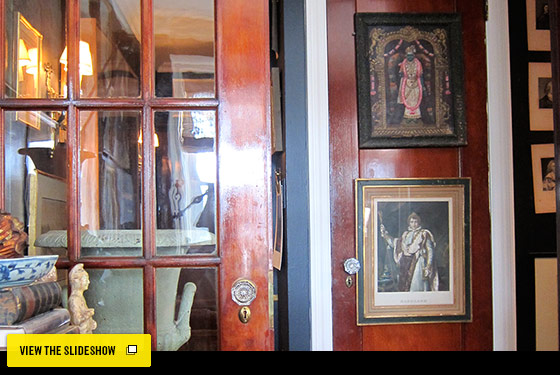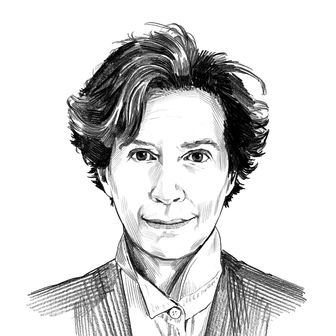

Randal Dawkins, an antiques and decorative-arts expert, arrived in New York nine years ago from London, where he received a master’s degree in fine and decorative art from Sotheby’s Institute of Art. As he gets ready to move to Hudson, New York, we visited him at his Sunset Park apartment that feels more like nineteenth-century London than 21st-century Brooklyn. “I grew up going to estate sales and auctions with my parents,” says Dawkins, a native of Valdosta, Georgia, explaining how he developed his eagle eye for collecting. Dawkins’s apartment originally belonged to the builder of the 1914 co-op, so the wood veneers were made of mahogany instead of the maple used in the other apartments. The hallway is painted in Farrow & Ball’s Black Blue, which serves as a handsome background for his collection of eighteenth-century neoclassic engravings. Photo: Wendy Goodman

An Empire bureau beside the William IV love seat in the living room holds a collection of Chinese Tang and Ming figures, a Ming cloisonné vase, a Ming Swatow-ware bowl and carved temple ornament, and a 1980 Artemide Tizio lamp. The portrait of a gentleman is English ca. 1680, and the drawing of a nude is ca. 1810. Photo: Wendy Goodman

Here’s a Louis XVI side chair in vintage chintz that Dawkins found for $15 at Goodwill. Every surface in the apartment holds books that don’t fit into the packed bookshelves. Photo: Wendy Goodman

Dawkins salvaged these columns from an Upper East Side contractor, cutting them down to fit as a dramatic demarcation between the living and dining room. They replaced the heavy Edwardian curtain rod he found when he moved in almost two years ago. The dining room beyond is painted in Benjamin Moore’s Calypso Blue. Photo: Wendy Goodman

The dining room is resplendent with Dawkins’s collection of seventeenth- and eighteenth-century English and Dutch Delft and sixteenth-to-eighteenth-century Chinese Export porcelain, while ca. 1810 Italian painted chairs line up against the wall. The portrait is English, ca. 1800. Photo: Wendy Goodman

It really pays off to have a well-trained eye as Dawkins discovered when he spotted this ca. 1810 Duncan Phyfe workshop mahogany sideboard at the City Opera Thrift shop. The Credit Suisse offices had off-loaded it. The 1998 oil on canvas above, Flagstone, is by Mike Childs. Photo: Wendy Goodman

Two Chinese baluster vases were converted into lamps in the dining room. The shades were ordered online from Laura Ashley, and Dawkins lined them with handmade marble paper for a softer light. Photo: Wendy Goodman

The bedroom is done in soothing tones of gray and white hand-painted stripes. The bed is adorned with a custom half-tester made of Turkish ikat fabric, along with a nineteenth-century Indian temple banner, all crafted together by Dawkins with a staple gun and straight pins. The hanging light fixture is a late-eighteenth-century bouillotte lamp. Photo: Wendy Goodman

The bedroom dresser is an Edwardian Chippendale-carved mahogany chest. The gilt-wood mirror is eighteenth-century Louis XVI. Unframed prints on the wall are hung using Dawkins’s collection of Victorian letter clips. Photo: Wendy Goodman

In the kitchen hangs a lantern from Visual Comfort in front of his collection of eighteenth- and nineteenth-century bibelots in the cupboards. Photo: Wendy Goodman

In Hudson, Dawkins is planning to open an antiques and fine arts shop called Acroterion. When I asked what that meant, he explained that an acroterion is the topmost ornament on a building, and showed me this gold lusterware pitcher decorated with acroterion-like motifs. It is one of his favorite pieces. Photo: Wendy Goodman

